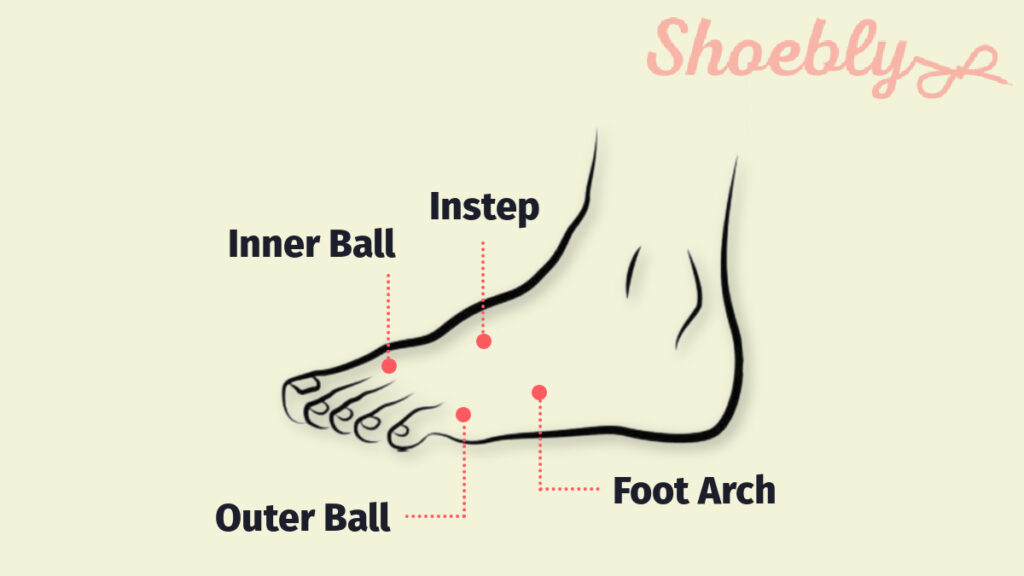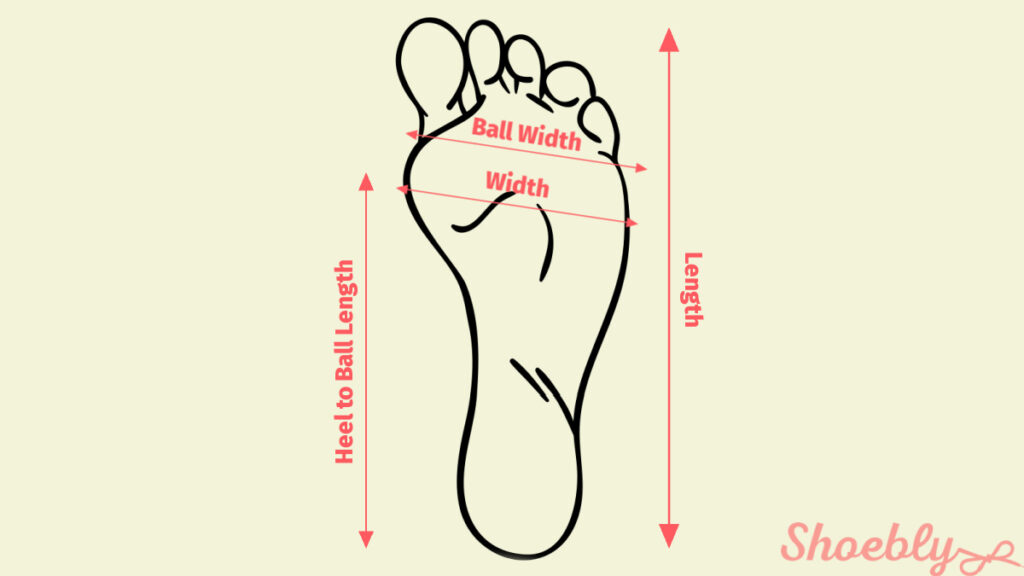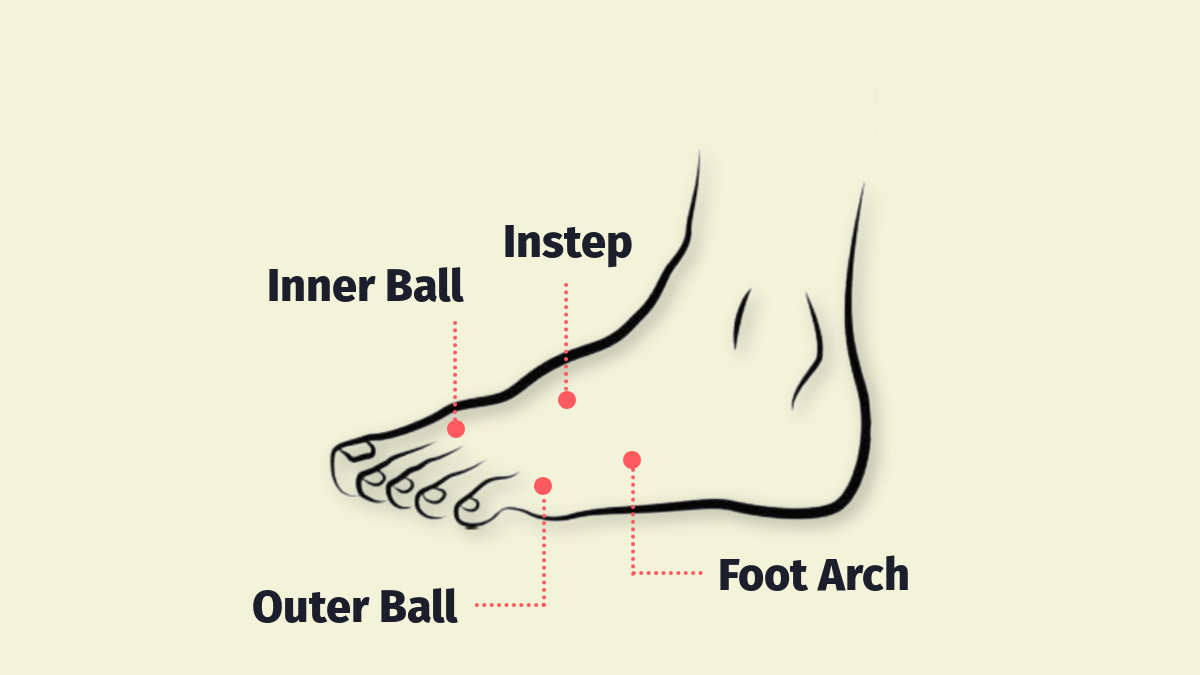When it comes to shoe fittings, foot anatomy you should know includes the inner ball near your big toe, the outer ball, the foot arch (located between the inner ball and heel), which is the area between your inner ball and heel, and your instep, or the top of your foot. Use these to measure your foot’s length, width, and ball girth while wearing socks.
I want to emphasize the importance of understanding foot anatomy, as neglecting this knowledge can lead to unintended consequences and discomfort.
Avoid purchasing shoes that have a “high instep” if you don’t know whether or not you have one of those. Don’t ignore the reviews that claim a model has no arch support if you have no idea where your arches are, much less how much support they might need.
The foot is more than just a number size.
In this article, I will tell you about your foot’s anatomy so you can get the right fit every time you buy a pair of shoes – dress shoes or sneakers.
Table of Contents
Quick Anatomy: Different Foot Parts Explained

Again, we’re going to focus on the foot’s anatomy as it’s relevant to shoe fit, not the actual anatomical science of it (though I’ll share some top level facts for clarity).
Complexity of Foot Anatomy
Your foot is a remarkably complex structure, consisting of over 30 joints, 26 bones, and an intricate network of muscles and ligaments.
It’s important to note that this article doesn’t substitute for professional podiatric advice, but it will certainly provide a deep understanding of the essential elements relevant to shoe fitting.
Foot Arch
From a podiatrist’s perspective, the overall human foot arch comprises three individual arches. However, for our purposes, we’re mainly looking at the lateral arch, which is the bottom area of your foot between your heel and the inner ball.
This is where the terms “flat feet” and “high arches” come from. Usually, this part of your foot doesn’t fully and consistently touch the ground.
However, if you have flat feet, most of this area (or even all of it) does touch the ground and does so consistently.
On the other end of the spectrum, if this area on your foot curves upward and almost never touches the ground, you have high arches. It also means that you need a shoe with good arch support, or your heel and your toe will be holding all of your weight.
Instep of Foot
What, and where, is the instep of your foot?
The instep is positioned between the ball of your foot and your leg. It is one of the more critical bottom parts of the foot to consider when measuring for shoes. Many snug-fitting dress shoes highlight a high instep in their design, offering extra room for comfort and breathability.
However, if your instep is exceptionally low, this feature may result in a need to tighten laces excessively, potentially compromising both aesthetics and comfort.
Ensure that the shoe’s last accommodates your instep height, and explore insole options for low insteps.
Inner Ball
The inner ball of your foot is the one closest to your big toe, and is where your foot bone meets your toe bone. It’s also the bigger ball when compared to the outer ball.
Outer Ball
The outer ball of your foot is the one where your foot bone meets your pinkie toe bone. As its name suggests, it’s on the outer side of your foot, and it’s also smaller than the inner ball.
Foot Dimensions (and How to Measure Them)

Now that you have your reference points, here’s how to get your foot’s dimensions.
Remember these two rules of thumb:
- Make sure to measure both feet. They’ll likely be different sizes. When you’re choosing shoes, you’ll go for the bigger size.
- In general, you should measure with socks on, since you’ll likely be wearing them with your shoes.
A medium-weight pair of socks should give you a pretty universal result.
However, if you want to be super specific, you can do a barefoot measurement or a measurement with thin no-show socks, a measurement with dress socks (since dress shoes should be form-fitting), and a measurement with thicker socks.
Ball Width
The foot ball width is the widest part of your foot.
To measure your foot’s ball width, you’ll take a measuring tape and measure the distance between your big toe joint and the small toe joint.
Since most sets of toes don’t come out from your foot in a straight line, the measuring tape will likely go from the widest side of the inner ball to the top of where the outer ball meets the pinkie toe. That’s okay since you’re still at the widest area of your foot.
Width
Your general width is likely going to be the same, or at least inconsequentially different from your ball width. However, this measurement can serve as extra, potentially helpful information in case a certain shoe model that should theoretically fit well isn’t doing so.
Everyone has different foot proportions, after all.
To measure the general width of your foot, stand up and press your foot against the wall. Make sure you’re pressing so that the weight of the foot is evenly distributed.
You’ll then measure the width similarly to the ball width to see if it differs significantly. This could be the case if you have naturally curvier foot proportions or if your significantly high or significantly low arch affects the way your foot weight is distributed depending on how much pressure is on it.
Length
The length is the measurement from your heel to the tip of your longest toe—pretty straightforward.
Here’s a trick that I’ve found helpful when I’m not feeling particularly dexterous with the measuring tape.
Tape a piece of paper on the floor (or the wall if you want to measure it that way). Make sure it’s bigger than your foot. Place your foot on it, and mark where your heel is and where your longest toe is with a pencil.
Now, you can just measure the distance between the two marks to get your foot length.
Heel to Ball Length
Similar to getting your overall length, you’ll get your heel-to-ball length by measuring the edge of your heel up to the widest part of your inner ball.
It’s important to get both lengths, especially for dress shoes. The widest part of your foot needs to sit comfortably and snugly in the shoe box. For loafers, this fit is paramount because it’s what locks your foot into the shoe.
You might have some room in front of your toes or behind your heels, but if the heel-to-ball length of the shoe isn’t placing the widest part of your foot in the shoe box, you need a different size or a different model that better accommodates your foot’s proportions.
Ball Girth
To get your ball girth, you’ll take a tape measure across the ball and all the way around the joints.
Bigger girths may require larger toe boxes or indicate a higher arch (but not always). Sometimes, simply incorporating insoles or replacing the factory insoles can accommodate whether there’s too much room or not enough room in the height of the shoe.
When you’re shopping retail, knowing the exact girth measurement is more of a way to let you know whether you’re generally bigger or generally smaller in that area. This helps you choose insoles or shoes based on last descriptions.
If you’re ever going to a bespoke shoemaker however, he’ll definitely use the exact measurement number to create the last.
Anatomically Correct
Another thing to keep in mind is to measure your foot in the middle of the day instead of in the morning to take swelling into account.
Even if you don’t use the exact numbers of your measurements all the time, having them will give you a clearer idea of what to look for in a shoe.
Knowing your foot’s anatomical names (and parts) will definitely shed light on product descriptions so you aren’t just shooting in the dark.
FAQs
What is the top of the foot called?
The top of the foot is called the instep. From a podiatric perspective, it’s a combination of the transverse arch and part of the medial arch.
Why does the bottom of my feet hurt after walking?
Foot soreness can result from various issues and activities, including exercise. Ill-fitting shoes, however, can lead to issues like swelling, cracked skin, and strains.
Why do shoes fit differently on each foot?
Most people have slightly different sized feet. Some have a bigger size gap than others. It’s important to always go for the bigger foot when choosing shoe sizes.
What are the common areas of foot pain?
The most common area of foot pain is the bottom of the foot. When the tissue becomes inflamed, it can cause stabbing pain as a result of a condition called plantar fasciitis.


Join the Discussion